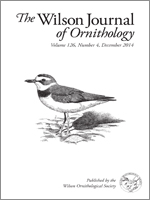The Spotted Barbtail (Furnariidae) is poorly studied but shows some extreme traits for a tropical passerine. We located and monitored 155 nests to study this species for 7 years in an Andean cloud forest in Venezuela. Spotted Barbtails have an unusually long incubation period of 27.2 ± 0.16 days, as a result of very long (3–6 hr) off-bouts even though both adults incubate. The long off-bouts yield low incubation temperatures for embryos and are associated with proportionally large eggs (21% of adult mass). They also have a long nestling period of 21.67 ± 0.33 days, and a typical tropical brood size of two. The slow growth rate of the typical broods of two is even slower in broods artificially reduced to one young. Nonetheless, the young stay in the nest long enough to achieve wing lengths that approach adult size.
How to translate text using browser tools
1 December 2014
Breeding biology of the Spotted Barbtail (Premnoplex brunnescens)
Daniel Muñoz,
Thomas E. Martin
ACCESS THE FULL ARTICLE
breeding biology
furnariid
growth rate
incubation attentiveness
Venezuela





